Click on images to enlarge
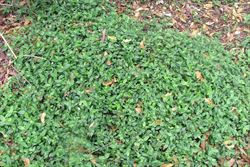
infestation (Photo: Sheldon Navie)

dense infestation in flower (Photo: Sheldon Navie)
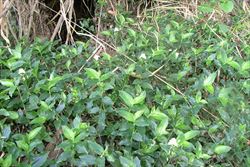
creeping habit (Photo: Sheldon Navie)

habit in flower (Photo: Sheldon Navie)
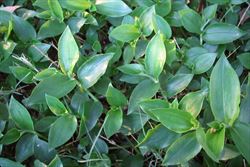
leaves (Photo: Sheldon Navie)
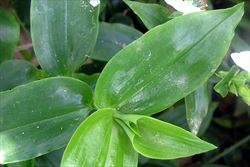
close-up of fleshy leaves with glossy upper surfaces (Photo: Sheldon Navie)
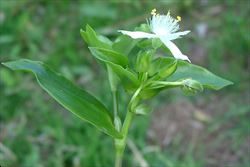
close-up of fleshy stem and flower cluster with flower from side-on (Photo: Sheldon Navie)

flower with three pointed white petals (Photo: Sheldon Navie)
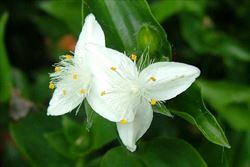
close-up of flowers with six yellow stamens covered with a beard of whitish hairs (Photo: Sheldon Navie)
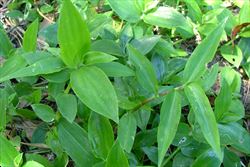
comparison of the leaves of trad (Tradescantia fluminensis), on the left, and native wandering Jew (Tradescantia diffusa), on the right (Photo: Sheldon Navie)
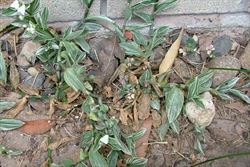
habit of variegated trad (Tradescantia fluminensis 'Variegata') growing in a garden (Photo: Sheldon Navie)
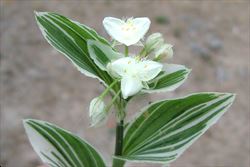
close-up of the leaves and flowers of Tradescantia fluminensis 'Variegata' (Photo: Sheldon Navie)
Scientific Name
Tradescantia fluminensis Vell.
Synonyms
Tradescantia albiflora Kunth
Family
Commelinaceae
Common Names
creeping Christian, green wandering Jew, inch plant, inch-plant, small leaf spiderwort, small-leaf spiderwort, spider wort, spider-wort, spiderwort, trad, wanderer, wandering creeper, wandering Jew, wandering trad, wandering tradescantia, wandering Willie, water spiderwort, white flowered wandering Jew, white-flowered wandering Jew
Origin
Native to South America (i.e. south-eastern Brazil, Argentina and Uruguay).
Cultivation
This species has been cultivated as a garden ornamental, particularly in the cooler and wetter parts of the country. A form with variegated leaves (i.e. Tradescantia fluminensis 'Variegata') has been particularly popular in cultivation. It has leaves with white, cream or yellowish-coloured stripes.
Naturalised Distribution
Widely naturalised in southern and eastern Australia (i.e. in eastern Queensland, eastern New South Wales, Victoria, Tasmania, south-eastern South Australia and south-western Western Australia). Also naturalised on Lord Howe Island.
Widely naturalised overseas in southern Europe (e.g. Portugal and Italy), the Canary Islands, southern Africa (i.e. South Africa and Swaziland), temperate Asia (e.g. Russia and Japan), New Zealand, the Galápagos Islands, Hawaii and southern USA (i.e. California, Florida, Georgia, Alabama, Louisiana and Kentucky).
Habitat
A weed of forests, forest margins, urban bushland, open woodlands, riparian vegetation, roadsides, ditches, waste areas, disturbed sites and gardens. It prefers damp and shaded areas in temperate and sub-tropical regions, but will also grow in more open habitats and in tropical regions.
Habit
A long-lived (i.e. perennial) herbaceous plant with trailing or creeping (i.e. prostrate or decumbent) stems up to 4 m long. It often grows as a groundcover and forms a dense mat of vegetation.
Distinguishing Features
- a somewhat fleshy long-lived herbaceous plant with trailing stems that produce roots at their joints.
- its shiny leaves have dark green upper surfaces and often slightly purplish undersides.
- these leaves are alternately arranged along the stems and have sheathed bases.
- its white flowers (about 2 cm across) have three pointed petals (7-10 mm long).
- these flowers are borne in small clusters near the tips of the branches.
Stems and Leaves
The stems are somewhat fleshy (i.e. semi-succulent) in nature, branched, and produce roots (i.e. adventitious roots) at each of the swollen joints (i.e. nodes).
The glossy leaves are alternately arranged and their bases form short sheaths (5-10 mm long) around the creeping stems. The somewhat fleshy (i.e. semi-succulent) leaf blades (3-6.5 cm long and 1-3 cm wide) are dark green on top and often slightly purplish underneath. They may be either broadly lance-shaped (i.e. lanceolate), egg-shaped in outline (i.e. ovate), or oblong with entire margins and pointed tips (i.e. acute apices). Leaf sheaths can be either hairy (i.e. pubescent) or hairless (i.e. glabrous), while the leaf blades are hairless, or occasionally with some small hairs (i.e. cilia) along their margins.
Flowers and Fruit
The flowers (about 2 cm across) are borne in small clusters near the tips of the branches. Each cluster has two small leafy bracts at the base and the individual flowers are borne on stalks (i.e. pedicels) 1-1.5 cm long. They have three white petals (7-10 mm long) with pointed tips (i.e. acute apices), three greenish sepals (6-8 mm long), and six small yellow stamens. Flowering occurs mainly during spring and summer.
The fruit are small capsules, with three chambers. However, this species is not known to produce viable seed in Australia. Black, pitted seeds are produced overseas.
Reproduction and Dispersal
This plant only reproduces vegetatively in Australia, by producing roots at the joints (i.e. nodes) of stems that come into contact with the soil (i.e. stolons).
Stem fragments easily break off and may be dispersed by water, vehicles, machinery, in dumped garden waste or in contaminated soil.
Environmental Impact
Trad (Tradescantia fluminensis) is a significant environmental weed in Victoria and New South Wales, an environmental weed in South Australia, Queensland and Tasmania, and a potential environmental weed in Western Australia and the ACT. It was recently listed as a priority environmental weed in four Natural Resource Management regions in Australia.
Legislation
This species is declared under legislation in the following states and territories:
- New South Wales: Class 4 - a locally controlled weed. The growth and spread of this species must be controlled according to the measures specified in a management plan published by the local control authority and the plant may not be sold, propagated or knowingly distributed (in the Hornsby, Ku-ring-gai, Lane Cove, Manly, North Sydney, Ryde and Willoughby local authority areas).
- Western Australia: Unassessed - this species is declared in other states or territories and is prohibited until assessed via a weed risk assessment (throughout the entire state).
Management
For information on the management of this species see the following resources:
- the Biosecurity Queensland Fact Sheet on this species, which is available online at http://www.dpi.qld.gov.au.
- the Randwick City Council environmental weeds profile on this species, which is available online at http://www.randwick.nsw.gov.au.
- the Shire of Yarra Ranges environmental weed fact sheet on this species, which is available online at http://www.yarraranges.vic.gov.au.
- the Wandering Jew page on the South Coast Weeds website at http://www.esc.nsw.gov.au/Weeds/index.asp.
Similar Species
Trad (Tradescantia fluminensis) can be easily confused with the native aneilema (Aneilema biflorum ). It is also relatively similar to native wandering Jew (Commelina diffusa ), hairy wandering Jew (Commelina benghalensis ) and zebrina (Tradescantia zebrina). These species can be distinguished by the following differences:
- trad (Tradescantia albiflora) has glossy green leaves that are mostly hairless and somewhat fleshy. Its flowers are white with three pointed petals.
- aneilema (Aneilema biflorum) has glossy green leaves that are hairless and somewhat fleshy. Its flowers are white with rounded petals.
- native wandering Jew (Commelina diffusa) has dull green leaves that are hairless and relatively thin. Its flowers are usually bright blue (rarely white) with rounded petals.
- hairy wandering Jew (Commelina benghalensis) has dull green leaves that are hairy and relatively thin. Its flowers are usually bright blue with rounded petals.
- zebrina (Tradescantia zebrina) has variegated purplish leaves that are hairless and somewhat fleshy. Its flowers are bright pink with rounded petals.
This fact sheet has been updated thanks to the sponsorship of Sunshine Coast Council.

